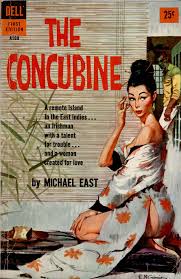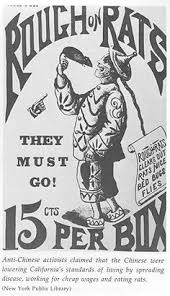On hearing the news I breathed a sigh of relief: something that had troubled me on an almost daily basis had now been recognized as derogatory at the highest level of government. This is critically important, because many people, even some Asian Americans themselves, don’t realize it. Just minutes before I read the news of H.R. 2438, I received an emailed reading response from a student on a short story by a Malaysian writer, in which my student used the term “Oriental” to make a sweeping generalization about life in ‘that part of the world’. Clearly the bill has not gone far enough, and neither has its coverage in the media, because they don’t explain why the term is derogatory. It’s not enough to be told, as H.R. 2438 does, that many Asian Americans find it offensive, since this can be dismissed as their problem, their hypersensitivity. Isn’t it just a descriptive term, its apologists ask, like “Westerner”?
No, “Oriental” is not merely descriptive (and neither, for that matter, is “Westerner”–or, to use parallel terminology, “Occidental”, which, tellingly, is rarely used). It is a term designed to categorize, generalize, dehumanize, and dominate. Let me explain, as briefly as I know how.
 First “Oriental” is an outdated term, based upon a 19th-century colonial concept of race that divided humankind into a hierarchy of racial types, with the Western European (man)–born to rule–at the top: Caucasoid, Negroid, Australoid, and Mongoloid, or Oriental, as it came to be known a little later. These terms have come to be associated with skin color and physical appearance, but also with stereotyped character traits, temperaments, and predelictions (again, with the Caucasian on top). All this has been debunked by scholars across the disciplines as a lot of baloney, and it is now generally accepted that this scientific racism was an ideology conveniently constructed to justify colonization of the “lesser breeds” by the naturally superior ones. In sum, “Oriental” was invented by Europeans for Europeans.
First “Oriental” is an outdated term, based upon a 19th-century colonial concept of race that divided humankind into a hierarchy of racial types, with the Western European (man)–born to rule–at the top: Caucasoid, Negroid, Australoid, and Mongoloid, or Oriental, as it came to be known a little later. These terms have come to be associated with skin color and physical appearance, but also with stereotyped character traits, temperaments, and predelictions (again, with the Caucasian on top). All this has been debunked by scholars across the disciplines as a lot of baloney, and it is now generally accepted that this scientific racism was an ideology conveniently constructed to justify colonization of the “lesser breeds” by the naturally superior ones. In sum, “Oriental” was invented by Europeans for Europeans.
Second, “Oriental” is a blanket term covering huge swaths of the world. It has been used to refer to the Middle East, South Asia, East Asia, and Southeast Asia, and given the tremendous differences among all these regions, is on the one hand almost completely meaningless and on the other, extremely harmful in encouraging people to lump them all together in their minds. For example, the student I mentioned above who wrote on the short story, Leng Lui Is for Pretty Lady, failed to notice that it was set in Hong Kong, its protagonist was from the Philippines, and its author, Elaine Chiew, is of Malaysian origin and has lived in Hong Kong and the United States, but now lives in London. To tell the truth, I myself failed to tease out these specificities while teaching the story, which is about the predicament of women who must leave their families and go abroad to work as maids in the global economy. My failure, and the term Oriental, allowed the student to conclude that this was “what it is like to be a woman living in servitude in an oriental country,” as my student put it. First, it generalized about the condition of all women in “the Orient”, and second, in allowing him to disregard the fact that there are women working as maids in exploitative conditions all over the world, including Europe and the United States, it performed the work for which, according to the late Edward Said, Orientalism was designed: to create an inferior Other which is the polar opposite of the so-called West, upon which the “West” projected all that it did not want to accept in itself.
Third, with regard to the term “Orient”, better known as “the East”, I ask the question, East of what? The answer, of course, is East of Greenwich, England, which Britain at the height of its empire declared the central reference point for measurements of longitude, for which Greenwich is the arbitrarily designated Prime Meridian. Everything East of Greenwich is East and everything West of it, West. But we are now a world with many centers, and it is time we changed our language to reflect this new reality. Now that Britain is just a small island again, with little power if it does not attach itself to the new global superpower, what sense does it make for people in its former colonies to continue to see it as the global Center and themselves as marginal, always obliged to look Westward for success and self-affirmation?
 Fourth, “Oriental” is used to demean, divide, and exclude. It is natural for people to see themselves as the central reference points of their lives, and it is understandable, if not desirable, for people to want to identify themselves with power. Perhaps that is why one still finds Asian Indians in the United States internalizing Orientalist stereotypes and identifying themselves with the “Caucasian” rather than “Oriental.” More than once I have heard Indian students of mine declaring that they are not Orientals, which prevents them from making common cause with other people of Asian origin under the useful umbrella of Asian American. And yet U.S. vs. Bhagat Singh Thind, the Supreme Court ruling of 1923, made it clear why it is in their interest to do—and in fact, to extend themselves still further to identify with all people of color. This was during the long period of first Chinese and Asian Indian, then Oriental Exclusion, when no one of Asian origin was allowed to immigrate to the U.S. or gain U.S. citizenship. The complainant in the Supreme Court case, an Asian Indian, had claimed that he should be granted citizenship because Indians are Caucasians, not Orientals. The judgment acknowledged, that Yes, he was Caucasian, but No, he could not be granted citizenship because he was not white, revealing the true purpose of these racial categories.
Fourth, “Oriental” is used to demean, divide, and exclude. It is natural for people to see themselves as the central reference points of their lives, and it is understandable, if not desirable, for people to want to identify themselves with power. Perhaps that is why one still finds Asian Indians in the United States internalizing Orientalist stereotypes and identifying themselves with the “Caucasian” rather than “Oriental.” More than once I have heard Indian students of mine declaring that they are not Orientals, which prevents them from making common cause with other people of Asian origin under the useful umbrella of Asian American. And yet U.S. vs. Bhagat Singh Thind, the Supreme Court ruling of 1923, made it clear why it is in their interest to do—and in fact, to extend themselves still further to identify with all people of color. This was during the long period of first Chinese and Asian Indian, then Oriental Exclusion, when no one of Asian origin was allowed to immigrate to the U.S. or gain U.S. citizenship. The complainant in the Supreme Court case, an Asian Indian, had claimed that he should be granted citizenship because Indians are Caucasians, not Orientals. The judgment acknowledged, that Yes, he was Caucasian, but No, he could not be granted citizenship because he was not white, revealing the true purpose of these racial categories.
 Calling someone an Oriental, even if their families have lived, worked, paid taxes, and died in the United States for generations, excludes them from full Americanness by relegating them firmly to the status of permanent outsider, unassimilable alien, regardless of their American citizenship. It designates them as Other, not one of Us, not from here, and in the end neither equal nor fully human. Just a glance at the stereotypical images of “Orientals” that are rife in the visual media makes this abundantly clear. These stereotypes also ought to make it obvious why the term is so hurtful.
Calling someone an Oriental, even if their families have lived, worked, paid taxes, and died in the United States for generations, excludes them from full Americanness by relegating them firmly to the status of permanent outsider, unassimilable alien, regardless of their American citizenship. It designates them as Other, not one of Us, not from here, and in the end neither equal nor fully human. Just a glance at the stereotypical images of “Orientals” that are rife in the visual media makes this abundantly clear. These stereotypes also ought to make it obvious why the term is so hurtful.
My final point—and forgive me, I am an English teacher—is about the politics of grammar. “Oriental” is an adjective, not a noun. So to call a person “an Oriental” is to define him or her based on physical appearance and an imaginary repertoire of pre-ordained traits seen as belonging to that racial category. It is derogatory, dehumanizing, and high time for it to be defunct.
I hope it is now clear to you what’s wrong with “Oriental.” Hooray for the passage of H.R. 2438, and Thank You, Congresswoman Grace Meng!
![[from megangillman.wordpress.com]](https://josna.files.wordpress.com/2016/06/screen-shot-2015-04-05-at-3-37-18-pm.png?w=604)


This is a wonderful essay, Josna, where you present logical and appropriate arguments that the use of the term ‘oriental’ as a generic term is derogatory and dehumanising. Anyone who tries to refute them would only show up their own racist attitude.
The U.S. situation where non-whites were not allowed to become permanent settlers, has its echo in the “White Australia Policy” which existed for two-thirds of the 20th century. That policy is no longer officially in operation. However, in its approach to refugees from the Middle East and other areas, I believe our current government is espousing that very concept, and it appals and shames me as an Australian!
LikeLiked by 1 person
Well done. Amazing how the posts we agonize over often turn out to be among the best.
LikeLike
Excellent and informative post.
LikeLiked by 1 person
Thank you! I agonized over this one.
LikeLike
You presented the arguments so well- and what you say makes complete sense.
LikeLiked by 1 person
It’s a relief to hear it. I felt the need to explain further, but also wanted to keep it relatively short. Fortunately, the images and hyperlinks can do a lot of that explanatory work for me.
LikeLike